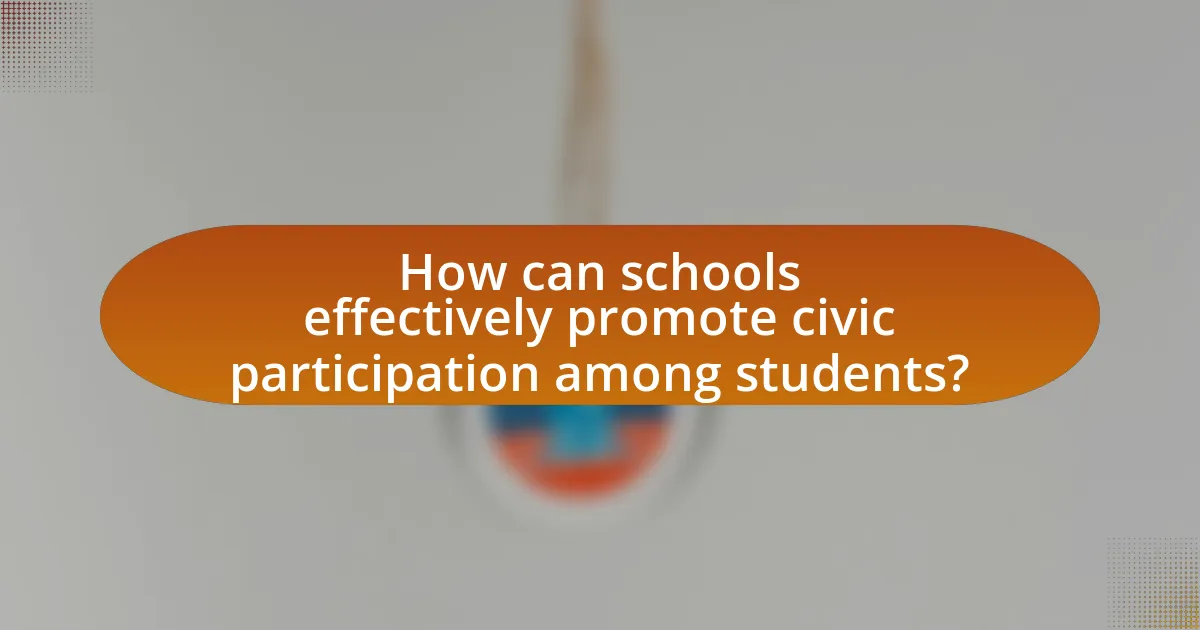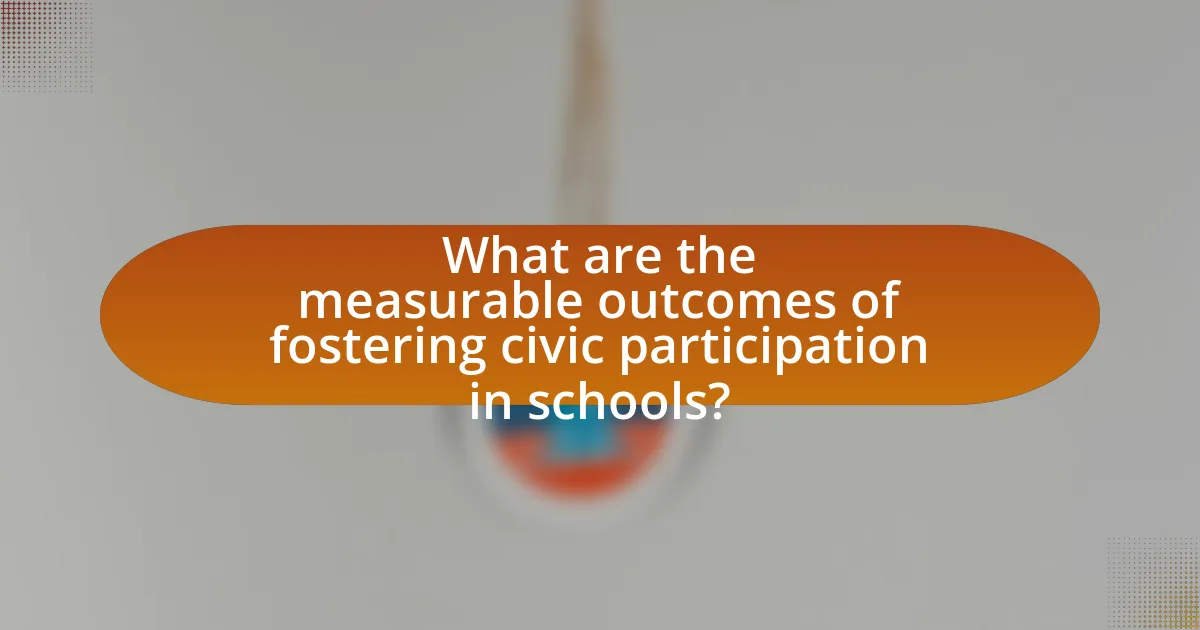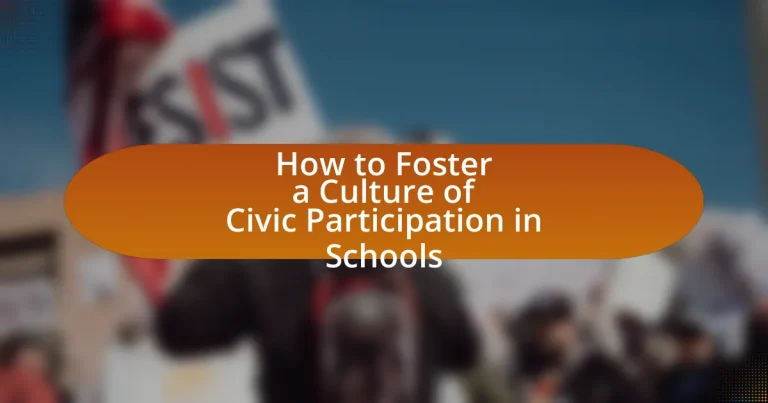Fostering a culture of civic participation in schools involves creating an environment that encourages students to engage in civic activities and responsibilities. This article outlines the definition of civic participation in education, key elements such as student engagement and community involvement, and the importance of integrating civic education into the curriculum. It also addresses current challenges schools face, including resource limitations and insufficient educator training, while highlighting effective strategies for promoting civic engagement, such as service-learning and project-based learning. Additionally, the article discusses the role of community partnerships and extracurricular activities in enhancing civic participation, as well as the measurable outcomes and best practices for sustaining a culture of active citizenship among students.

What does it mean to foster a culture of civic participation in schools?
Fostering a culture of civic participation in schools means creating an environment where students are actively encouraged and supported to engage in civic activities and responsibilities. This involves integrating civic education into the curriculum, promoting student involvement in community service, and facilitating discussions on social issues. Research indicates that schools that prioritize civic engagement see higher levels of student participation in democratic processes, such as voting and community organizing, which is essential for developing informed and active citizens.
How can civic participation be defined in the context of education?
Civic participation in the context of education can be defined as the active engagement of students, educators, and the community in democratic processes and decision-making that influence their educational environment and society at large. This engagement includes activities such as voting in school board elections, participating in student government, and collaborating on community service projects, which collectively foster a sense of responsibility and empowerment among students. Research indicates that schools that promote civic participation not only enhance students’ understanding of democratic principles but also improve their academic performance and social skills, as evidenced by studies conducted by the Center for Information and Research on Civic Learning and Engagement.
What are the key elements of civic participation in schools?
The key elements of civic participation in schools include student engagement, community involvement, and curriculum integration. Student engagement fosters active participation in decision-making processes, allowing students to voice their opinions and contribute to school governance. Community involvement encourages partnerships between schools and local organizations, enhancing real-world learning experiences and promoting civic responsibility. Curriculum integration ensures that civic education is embedded in various subjects, equipping students with the knowledge and skills necessary for informed citizenship. These elements collectively create an environment that values and promotes civic participation among students.
Why is civic participation important for students?
Civic participation is important for students because it fosters a sense of responsibility and engagement in their communities. Engaging in civic activities helps students develop critical thinking skills, understand democratic processes, and recognize the impact of their actions on society. Research indicates that students who participate in civic activities are more likely to vote and engage in community service as adults, demonstrating the long-term benefits of early involvement. For instance, a study by the Center for Information and Research on Civic Learning and Engagement found that students involved in civic education programs showed increased civic knowledge and participation rates.
What are the current challenges to civic participation in schools?
Current challenges to civic participation in schools include a lack of resources, insufficient training for educators, and limited student engagement. Schools often face budget constraints that hinder the implementation of civic education programs, resulting in inadequate opportunities for students to learn about civic responsibilities. Additionally, many teachers lack the necessary training to effectively facilitate discussions on civic issues, which can lead to a disengaged classroom environment. Research indicates that when students do not see the relevance of civic participation to their lives, their motivation to engage diminishes, further exacerbating the issue.
How do societal factors influence civic engagement in education?
Societal factors significantly influence civic engagement in education by shaping the values, norms, and resources available to students and educators. For instance, communities with strong social networks and active civic organizations tend to foster higher levels of student participation in civic activities, as evidenced by research from the National Conference on Citizenship, which found that students in such environments are more likely to engage in volunteerism and community service. Additionally, socioeconomic status impacts access to educational resources and opportunities for civic involvement; students from higher socioeconomic backgrounds often have more access to extracurricular programs that promote civic engagement. This correlation highlights how societal structures and community dynamics directly affect the level of civic participation among students in educational settings.
What barriers do schools face in promoting civic participation?
Schools face several barriers in promoting civic participation, including limited resources, lack of trained educators, and insufficient curriculum integration. Limited resources hinder schools from providing necessary programs and activities that encourage civic engagement. Additionally, many educators lack training in civic education, which affects their ability to effectively teach students about civic responsibilities and participation. Furthermore, the absence of a structured curriculum that emphasizes civic engagement results in missed opportunities for students to learn about and practice civic participation. These barriers collectively impede the development of a culture of civic participation within schools.

How can schools effectively promote civic participation among students?
Schools can effectively promote civic participation among students by integrating service-learning programs into the curriculum. Service-learning combines community service with academic instruction, allowing students to engage in meaningful projects that address local issues while enhancing their understanding of civic responsibilities. Research indicates that students involved in service-learning demonstrate increased civic knowledge and engagement; for instance, a study by the National Service-Learning Clearinghouse found that 85% of participants reported a greater understanding of community needs and civic roles. By fostering these experiences, schools can cultivate a generation of informed and active citizens.
What strategies can educators implement to encourage civic engagement?
Educators can implement strategies such as integrating service-learning projects into the curriculum to encourage civic engagement. Service-learning combines community service with academic instruction, allowing students to apply their learning in real-world contexts. Research shows that students who participate in service-learning are more likely to engage in civic activities, as evidenced by a study from the National Service-Learning Clearinghouse, which found that 85% of students involved in service-learning reported increased civic responsibility. Additionally, educators can facilitate discussions on current events and social issues, fostering critical thinking and encouraging students to voice their opinions. This approach has been supported by findings from the Center for Information and Research on Civic Learning and Engagement, which indicate that students who discuss civic issues in class are more likely to participate in civic activities outside of school.
How can project-based learning enhance civic participation?
Project-based learning enhances civic participation by engaging students in real-world issues that require them to collaborate, problem-solve, and take action within their communities. This educational approach fosters critical thinking and encourages students to explore civic responsibilities through hands-on projects, such as community service initiatives or local advocacy campaigns. Research indicates that students involved in project-based learning demonstrate increased civic knowledge and a greater likelihood of participating in civic activities, as evidenced by a study published in the “Journal of Educational Psychology,” which found that students who engaged in community-based projects reported higher levels of civic engagement and social responsibility.
What role do extracurricular activities play in fostering civic engagement?
Extracurricular activities play a crucial role in fostering civic engagement by providing students with opportunities to develop leadership skills, collaborate with peers, and engage with their communities. These activities, such as student government, community service clubs, and debate teams, encourage students to take initiative and participate in civic life. Research indicates that students involved in extracurricular activities are more likely to vote and participate in community events, as they gain a sense of responsibility and connection to societal issues. For instance, a study published in the Journal of Educational Psychology found that students who participated in service-learning programs reported higher levels of civic engagement compared to their peers who did not participate. This demonstrates that extracurricular activities not only enhance personal development but also cultivate a culture of active citizenship among students.
How can community partnerships support civic participation in schools?
Community partnerships can enhance civic participation in schools by providing resources, expertise, and opportunities for students to engage with their local communities. These partnerships facilitate programs such as service learning, where students apply classroom knowledge to real-world issues, fostering a sense of responsibility and civic engagement. Research indicates that schools with strong community ties report higher levels of student involvement in civic activities, as evidenced by a study from the National Service-Learning Clearinghouse, which found that service-learning programs significantly increase students’ civic knowledge and skills. By collaborating with local organizations, schools can create a supportive environment that encourages students to participate actively in civic life.
What types of community organizations can collaborate with schools?
Community organizations that can collaborate with schools include non-profit organizations, local businesses, faith-based organizations, civic groups, and educational institutions. Non-profit organizations often provide resources and programs that enhance educational experiences, while local businesses can offer internships and mentorship opportunities. Faith-based organizations may contribute to community service projects and character education. Civic groups can engage students in local governance and community issues, fostering civic responsibility. Educational institutions, such as colleges and universities, can partner with schools for research projects and tutoring programs, enriching the learning environment.
How can schools leverage local resources to enhance civic education?
Schools can leverage local resources by partnering with community organizations, local government, and civic leaders to create experiential learning opportunities that enhance civic education. For instance, schools can organize field trips to local government offices, invite guest speakers from civic organizations, and engage students in community service projects. Research indicates that students who participate in service-learning programs demonstrate increased civic knowledge and engagement, as evidenced by a study from the National Service-Learning Clearinghouse, which found that service-learning enhances students’ understanding of civic responsibilities and community involvement. By utilizing these local resources, schools can provide students with practical experiences that reinforce the principles of civic education.

What are the measurable outcomes of fostering civic participation in schools?
Fostering civic participation in schools leads to measurable outcomes such as increased student engagement, improved academic performance, and enhanced civic knowledge. Research indicates that students involved in civic activities demonstrate higher levels of motivation and commitment to their education, which correlates with better grades and attendance rates. For instance, a study by the Center for Information and Research on Civic Learning and Engagement found that students who participate in service-learning programs show a 20% increase in academic achievement compared to their peers. Additionally, these students often exhibit a greater understanding of civic responsibilities and rights, as evidenced by assessments that measure civic knowledge and skills.
How can schools assess the impact of civic engagement initiatives?
Schools can assess the impact of civic engagement initiatives by utilizing surveys, focus groups, and performance metrics. Surveys can measure student attitudes towards civic responsibility before and after participation in initiatives, providing quantitative data on changes in perception. Focus groups can offer qualitative insights into student experiences and the perceived value of civic activities. Additionally, performance metrics, such as participation rates in civic events and community service hours logged, can provide concrete evidence of engagement levels. Research indicates that schools implementing these assessment methods can effectively gauge the success of their civic initiatives, as demonstrated in studies like “Civic Engagement in Schools: A Study of the Impact of Service Learning” by the National Youth Leadership Council, which found that structured assessments lead to improved civic outcomes.
What indicators can be used to measure student involvement in civic activities?
Indicators that can be used to measure student involvement in civic activities include participation rates in community service projects, attendance at civic-related events, and engagement in student government or leadership roles. These indicators provide quantifiable data reflecting students’ active roles in civic engagement. For instance, a study by the National Youth Leadership Council found that students who participate in service-learning programs demonstrate higher levels of civic knowledge and engagement, indicating that such participation is a reliable measure of civic involvement. Additionally, surveys assessing students’ attitudes towards civic responsibilities and their self-reported engagement in civic activities can further validate these indicators.
How does civic participation influence student development and academic success?
Civic participation significantly enhances student development and academic success by fostering critical thinking, social responsibility, and engagement in the learning process. Students involved in civic activities, such as volunteering or participating in community service, develop essential skills like leadership, teamwork, and communication, which are crucial for academic achievement. Research indicates that students who engage in civic participation tend to have higher GPAs and are more likely to pursue higher education. For instance, a study published in the Journal of Educational Psychology found that students who participated in service-learning programs showed improved academic performance and a greater sense of civic responsibility. This correlation underscores the positive impact of civic engagement on both personal growth and educational outcomes.
What best practices can schools adopt to sustain a culture of civic participation?
Schools can sustain a culture of civic participation by integrating service-learning programs into their curricula. Service-learning combines community service with academic instruction, allowing students to engage in meaningful projects that address local issues while enhancing their learning experience. Research shows that students involved in service-learning demonstrate increased civic knowledge and engagement, as evidenced by a study published in the “Journal of Experiential Education,” which found that 85% of participants reported a greater understanding of civic responsibilities. Additionally, schools can establish partnerships with local organizations to provide students with opportunities for real-world civic engagement, further reinforcing the importance of active participation in their communities.
How can schools create a long-term vision for civic engagement?
Schools can create a long-term vision for civic engagement by integrating civic education into their curricula and fostering partnerships with community organizations. This approach ensures that students not only learn about civic responsibilities but also actively participate in community service and local governance. Research indicates that schools with structured civic engagement programs, such as the “Civic Learning and Engagement” initiative by the National Education Association, show improved student outcomes in civic knowledge and participation. By establishing clear goals, providing resources, and involving stakeholders, schools can cultivate a sustainable culture of civic participation that empowers students to become active citizens.
What role does professional development play in fostering civic participation among educators?
Professional development plays a crucial role in fostering civic participation among educators by equipping them with the knowledge and skills necessary to engage students in civic activities. Through targeted training programs, educators learn effective strategies for teaching civic responsibility, promoting critical thinking, and facilitating discussions on social issues. Research indicates that when educators participate in professional development focused on civic education, they are more likely to implement civic engagement practices in their classrooms, leading to increased student participation in community and civic activities. For instance, a study by the Center for Information and Research on Civic Learning and Engagement found that teachers who received training in civic education reported higher levels of student engagement in civic activities, demonstrating the direct impact of professional development on fostering a culture of civic participation.
What practical tips can schools implement to enhance civic participation?
Schools can enhance civic participation by integrating service-learning projects into their curriculum. Service-learning combines community service with academic instruction, allowing students to engage in real-world issues while developing civic skills. Research shows that students involved in service-learning are more likely to vote and participate in community activities, as evidenced by a study from the National Youth Leadership Council, which found that 85% of students who participated in service-learning reported increased civic engagement. Additionally, schools can host civic forums and debates, encouraging students to discuss and analyze current events, which fosters critical thinking and civic awareness. Implementing these strategies can significantly increase students’ involvement in civic activities.


